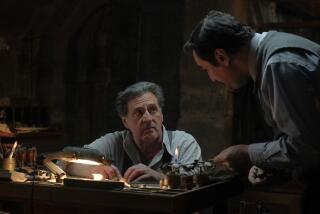The French detection
Lately, English-language publishers have developed an unfortunate habit with crime fiction in translation: Instead of starting at the very beginning of a series -- as Pantheon did in bringing out the 10-book “Story of Crime” opus by Swedes Maj Sjowall and Per Wahloo in the proper sequence -- books appear out of order, in haphazard fashion.
Heads are still being scratched over why “The Man Who Smiled,” the fourth outing of Henning Mankell’s popular detective, Inspector Kurt Wallander, was the last to be published in America. Because Jo Nesbo’s Norwegian sleuth, Harry Hole, first showed up on British soil with “The Devil’s Star” -- book five in the series -- it spoiled important plot points in “The Redbreast” (book three) and “The Redeemer” (book four), published in subsequent years. And I can’t help but wonder if Stieg Larsson had lived to complete all 10 books he allegedly envisioned for his series characters Lisabeth Salander and Mikael Blomkvist, “The Girl With the Dragon Tattoo” would have been published in English long after some mythical fifth or sixth volume took the entire world by storm.
Publishers choose the nonlinear approach for all sorts of reasons, such as commercial viability and what book in a series may grab reader attention best, so they will seek out earlier installments. “Jar City,” for example, was a smart choice to introduce Iceland’s undisputed crime-writing star Arnaldur Indridason because it was a major step forward, creatively and sales-wise, from the first two books featuring Inspector Erlendur (which remain untranslated). But readers who want to commit wholesale to a new series character and follow him or her through all manner of delightful and dangerous adventures are understandably frustrated at the disregard for series order.
Nowhere is the lack of linearity more clear than in the publishing history of Fred Vargas, a French architect turned crime writer who has been showered with untold awards around the world for her novels featuring Commissaire Jean-Baptiste Adamsberg, the chief of police of Paris’ 7th Arrondissement. Like other detectives before him, Adamsberg is brilliant at his work, even if others disagree with his methods. He’s haunted by Camille, a long-ago lover who flits in and out of his life periodically and is more present in his mind when she is furthest away. Americans first met him in “Have Mercy on Us All” (Simon & Schuster: 368 pp., $14 paper) -- book No. 4 -- in which he found a plausible conclusion to what appeared to be a rising body count attributed to the return of the Black Plague. Book No. 3, “Seeking Whom He May Devour” (Simon & Schuster, 289 pp., $14 paper), came next, asking readers to buy into the possibility of werewolves in a remote French village. And the most recent entry, “This Night’s Foul Work” (Penguin, 409 pp., $14 paper), includes a policeman prone to talking in rhyming verse and a cat prone to more than a drink or two -- and both are integral to the strange plot at hand.
But then, Adamsberg himself is such a bizarre character, so off-the-charts in what he would deem logical deductive reasoning, that it makes perfect sense to meet him at different, random stages of the series. Consider his connection-making in “Wash This Blood Clean From My Hand” (Penguin, 388 pp., $14 paper), sixth in the series but the third published here. Adamsberg is on the trail of a mad killer whose victims bear a signature wound of three perfectly straight lines and who -- in his mind -- has been framing others for his handiwork for more than five decades, as Adamsberg explains to his long-suffering and patient deputy, Danglard: “It comes to the same thing. What’s so striking about the differences [in the wounds] is that they’re tiny . . . absolutely tiny. The space between the perforations, in whatever direction, may vary. But the variation is always small. Look at them again. Whatever the distribution, the maximum length of the line is never more than 16.9 centimetres.” And did we mention the aforementioned killer has been dead since 1987? No matter; Adamsberg has his pet theory to fixate upon, and the astonishing part is that Vargas layers enough plausible clues within the outlandish framework to tie everything together.
In fact, one could argue that Vargas’ series could not work if not for Adamsberg’s outsized theories, because the emphasis is less on actual detection and more on the tension between believability and implausibility. Which is why it’s about time that “The Chalk Circle Man” (Penguin: 248 pp., $14 paper), the origin story of the “small, solid, darkly complexioned figure” of Adamsberg is finally being published in the U.S. this month. Vargas quickly establishes Adamsberg as a peculiar talent who puzzles his fellow cops: “Over the next five years, he had solved, one after another, four murders in a way that his colleagues had found uncanny, in other words unfair and provocative. ‘Don’t get above yourself, Adamsberg,’ they’d said. ‘You sit around daydreaming, staring at the wall, or doodling on a bit of paper as if you had all the time and knowledge in the world, and then one day you swan in, cool as a cucumber, and say “Arrest the priest. He strangled the child to stop him talking.” ’ “
Following such leaps of logic, Adamsberg insists that the unknown figure responsible for drawing blue chalk circles around random objects will graduate to more violent crimes -- and is proved right with a spate of horrific murders. But even though Vargas hasn’t reached the peak of her plotting powers yet, “The Chalk Circle Man” still contains surprises nested upon each other like matryoshka dolls, as well as the bald, utterly appropriate explanation of the killer’s crimes in 360-degree chalk: “so that lost things would belong to me, would be grateful to me.” Commissaire Adamsberg too is a keeper of lost causes, burning his candle brightest and longest in a bid to settle the dust on the most impossible crimes.
Sarah Weinman blogs about crime and mystery fiction at www.sarahweinman.com. Dark Passages appears monthly at www.latimes.com/books.
More to Read
The biggest entertainment stories
Get our big stories about Hollywood, film, television, music, arts, culture and more right in your inbox as soon as they publish.
You may occasionally receive promotional content from the Los Angeles Times.






